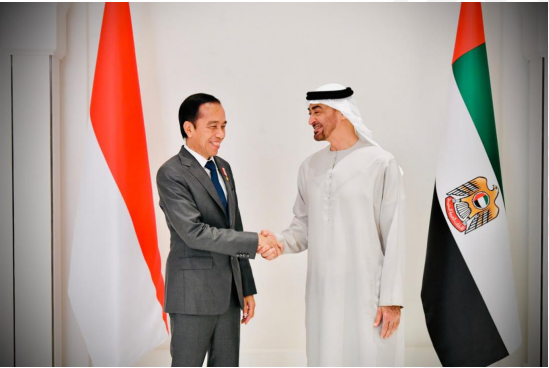
UAE President H.H. Sheikh Mohamed bin Zayed Al Nahyan and Indonesian President Joko Widodo at the signing of the UAE-Indonesia Comprehensive Economic Partnership Agreement, July 2022 Source: The Jakarta Post
Links between the Gulf and Southeast Asia date back centuries. It was Arab merchants from the Hadhramaut Valley in Yemen who introduced Islam to modern-day Indonesia and Malaysia. Direct contact was interrupted by Portuguese, Dutch, and then British occupation from the seventeenth century until the nineteenth century when the British customs regime began to attract Arab and Chinese traders alike. The Dutch, along with the Japanese, impacted the Indonesian political system through the establishment of a People’s Council and Council of Indonesian Muslim Associations respectively, but naturally, Saudi Arabia has enjoyed religious influence over the majority of Indonesia’s large population (273 million as of 2020) who identify as Sunni Muslim.
Influenced by this early contact with Arab merchants, Muslims from the Malay-Indonesia region have traveled in large numbers to Makkah for the Pilgrimage, a rite of passage for Muslims, and to enrich their understanding of the Islamic faith and the Arabic language of the Holy Quran. Much of these religious studies have taken place within institutional settings including the Islamic University of Madinah, and Al Imam Muhammad ibn Saud Islamic University in Riyadh, Saudi Arabia. In Malaysia, the Ibn Khaldun International Institute of Advanced Research has taken the lead, and in Indonesia, Pondok Modern Darussalam Gontor in East Java, Pondok Pesantren Sarang Al-Anwar in Central Java, and Pesantren Darunnajah in Jakarta have been highly influential in instilling Islamic education in the local Muslim population.
The Arab-Islamic influence over the region is in stark contrast to the force projection of the United States after World War II and which expanded into Cold War treaty alliances with Australia, Japan, the Republic of Korea, the Philippines, and Thailand. The U.S. and Russia further exerted their influence, pursuing their interests through interventions in various crises and conflicts in South Vietnam, Laos, Afghanistan, and Cambodia. The U.S. went on to expand ties with the Association of Southeast Asian Nations (ASEAN), the primary political and economic union of 10 states in Southeast Asia, including Indonesia.
The Indo-Pacific Strategy of the United States which launched in February 2022 includes elements such as high-standards trade, digital economy and connectivity, supply chain resiliency, transparent investment in infrastructure, and other economic ties. The U.S. remains the top arms supplier for all the GCC states, as well as for Indonesia and Australia, and continues to project power into the region through Diego Garcia, a joint naval facility shared with the British, part of the disputed Chagos Archipelago that stretches across some 640,000 square kilometers of the Indian Ocean. The U.S. has also continued to form a close security alliance with Australia, India (which has been expanding its own military partnerships with maritime neighbours), Japan, and the UK, through the Quadrilateral Security Dialogue, commonly known as the QUAD. In September 2021, Australia, the UK and US formed the AUKUS pact focused on expanding security on nuclear power submarines and research into advanced capabilities such as hypersonic weapons.
Analysts point to these developments as amounting to an ‘Asian NATO’ against a rising China. China in turn is stepping up military cooperation and exercises in the region and has deepened economic cooperation with South Asian states such as Bangladesh, Maldives, and Sri Lanka. Its ‘Blue Dragon’ strategy is said to be anchored by Sri Lanka and Taiwan, dubbed two ‘unsinkable’ aircraft carriers, and aims to expand China’s reach in the South China Sea, East China Sea, and the Indian Ocean through supported economic and military projects.
In contrast, religion and trade are at the forefront of contemporary GCC state engagement in Southeast Asia. Relations with Saudi Arabia remain dominated by hydrocarbon exports to the region, but as the Kingdom diversifies its economy within a sub-region still experiencing multiple sources of conflict and insecurity, maritime security has been of increasing concern to decision makers in Riyadh. Saudi Arabia, the UAE, Qatar, and Oman are members of the Indian Ocean Naval Symposium, along with Iran and many other littoral states in Asia such as Singapore, Indonesia, and Malaysia. Saudi Arabia has also signed a number of defence cooperation agreements, including with Indonesia in 2014, based on training, counterterrorism, and defence industry cooperation. Indonesia, Saudi Arabia, and the UAE are members of the Global Counterterrorism Forum (GCTF) and share an interest in combatting violent Islamist groups such as Al Qaeda and Islamic State which have been active in both regions.
Aid and development spending followed. In 2015, Indonesia was one of the target countries for a $32 billion charitable donation from Prince Alwaleed bin Talal, and the King Salman Center for Humanitarian Aid and Assistance donated $82 million to Indonesia between 2015 and 2019. The Kingdom announced an $800 million package in March 2023 to support development in Asia and Africa. Yet, non-oil trade and foreign investment have remained low despite the high-profile visit of King Salman to Asia (Malaysia, Indonesia, Japan, and China) in 2017 and various MoUs designed to boost cooperation across trade, education, health, culture, pilgrimage, tourism, science and technology, civil aviation, fisheries, and security. In 2023, during an official visit to Riyadh, Trade Minister Zulkifli Hasan of Indonesia officially asked Riyadh to boost trade cooperation, stating that “intensive communication between the government and the business sector is very important for encouraging an increased bilateral trade between the two countries.”
Indonesian worker’s rights in the GCC states have been the basis for contention in the past.
However, even though these issues were addressed in 2018 as far as the case of Saudi Arabia is
concerned, there remain persistent and systemic issues within the overall business model of
migrant labor in the Gulf region. Saudi–Indonesian relations have been specifically strained at
various times due to Indonesia’s support for Kuwait’s mediation efforts during the GCC crisis
(2017-21) and the boycott of Qatar led by Saudi Arabia and the UAE. More serious was Saudi
Arabia’s alleged influence over Indonesia’s position in the UN Human Rights Council on
extending the independent war crimes investigation in Yemen. Overall, there are evolving
opportunities within the Saudi Vision 2030 framework and Indonesia’s continued economic
transition. Bilateral relations are expected to develop along similar lines as Kuwait, Qatar, Bahrain,
and Oman.
The UAE, in contrast to other GCC states, has led on commercial activity with Indonesia, with a comprehensive economic partnership agreement signed in 2022, building on already relatively high bilateral non-oil trade at $2 billion in 2020 and $23 billion in deals signed during then Crown Prince Mohammed bin Zayed’s visit to Indonesia in 2019. Masdar is expected to help triple thecapacity of Southeast Asia’s largest floating solar plant which is located in West Java. SheikhZayed Grand Mosque in Solo, Central Java, echoes the kind of grand project religious support that Saudi Arabia was known for in South Asia in the past. At this pace the UAE could become a leading trading partner with Indonesia, alongside China, the US, Japan, Singapore and India.
Like Saudi Arabia, the UAE is also concerned about maritime security but has been concerned that its participation in a US-led Combined Maritime Forces is incompatible with de-escalation with Iran and stopped taking part in it from May 2023. As a rising power, its maritime policies in other parts of the world will likely reflect its more independent national interests over simply bandwagoning with regional and hegemonic powers. However, as Payne notes, Indo-Pacific information sharing processes could be one area that influences UAE policy back in the Gulf. Similar to its global policies that aim to enhance prerequisite aspects for greater autonomy, such as climate change cooperation, food security, free trade agreements and defence agreements, these aspects all form part of the UAE–Indonesia bilateral relationship. IDEX is a vital state conveningpower for further security cooperation. As the UAE builds military–industrial capacity, further cooperation is taking place in the military domain, such as the development of rifles and drones. The UAE is also expanding its arms sales globally, including to Indonesia’s neighbour, Malaysia, serving their joint economic and security interests.
Sheikh Mohammed bin Zayed has taken a leading role in supporting the construction of a new Indonesian capital city in East Kalimantan, expected to cost $34 billion, in a familiar pattern, as the UAE similarly backed the new administrative capital in Egypt. His personal convening power is vital in the successful rollout of this multi-billion dollar project, and includes other prominent public figures such as Masayoshi Son, the billionaire founder of Japan’s SoftBank as well as former British Prime Minister Tony Blair. Mohammed bin Zayed was a guest at the G20 summit in Bali in November 2022, an important forum of international governance and one which also highlights global status of attendees.
Even if President Joko Widodo loses the next Indonesian presidential election in 2024, the economic and strategic imperatives of Indonesia maintaining close and cordial relations with the UAE are set for the years ahead. In an evolving strategic context in the Indo Pacific, the nature of UAE engagement will give the Emirates preferential access to a high growth market as well as a growing stake in great power relations as China continues to penetrate into the “Western Ocean,” illustrated by military base construction in the Spratly Islands and the Paracel Islands region.
The UAE approach could therefore serve as a template for many of the other GCC states which have yet to convert their economic, aid and development assistance into wider defence and security cooperation and a more geostrategic-orientated presence in this part of the world.
* Robert Mason is a non-resident fellow with the Gulf Research Center

